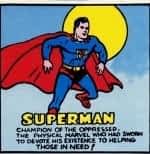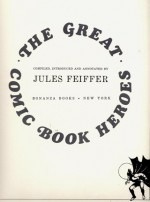 “As you know, I’m quite keen on comic books. Especially the ones about superheroes. I find the whole mythology surrounding superheroes fascinating. Take my favorite superhero, Superman. Not a great comic book. Not particularly well drawn. But the mythology … the mythology is not only great, it’s unique……About two minutes, just long enough for me to finish my point. Now, a staple of the superhero mythology is there’s the superhero and there’s the alter ego. Batman is actually Bruce Wayne, Spider-Man is actually Peter Parker. When that character wakes up in the morning, he’s Peter Parker. He has to put on a costume to become Spider-Man. And it is in that characteristic Superman stands alone. Superman didn’t become Superman. Superman was born Superman. When Superman wakes up in the morning, he’s Superman. His alter ego is Clark Kent. His outfit with the big red “S”, that’s the blanket he was wrapped in as a baby when the Kents found him. Those are his clothes. What Kent wears – the glasses, the business suit – that’s the costume. That’s the costume Superman wears to blend in with us. Clark Kent is how Superman views us. And what are the characteristics of Clark Kent? He’s weak, he’s unsure of himself, he’s a coward. Clark Kent is Superman’s critique on the whole human race.”
“As you know, I’m quite keen on comic books. Especially the ones about superheroes. I find the whole mythology surrounding superheroes fascinating. Take my favorite superhero, Superman. Not a great comic book. Not particularly well drawn. But the mythology … the mythology is not only great, it’s unique……About two minutes, just long enough for me to finish my point. Now, a staple of the superhero mythology is there’s the superhero and there’s the alter ego. Batman is actually Bruce Wayne, Spider-Man is actually Peter Parker. When that character wakes up in the morning, he’s Peter Parker. He has to put on a costume to become Spider-Man. And it is in that characteristic Superman stands alone. Superman didn’t become Superman. Superman was born Superman. When Superman wakes up in the morning, he’s Superman. His alter ego is Clark Kent. His outfit with the big red “S”, that’s the blanket he was wrapped in as a baby when the Kents found him. Those are his clothes. What Kent wears – the glasses, the business suit – that’s the costume. That’s the costume Superman wears to blend in with us. Clark Kent is how Superman views us. And what are the characteristics of Clark Kent? He’s weak, he’s unsure of himself, he’s a coward. Clark Kent is Superman’s critique on the whole human race.”
– Bill, Kill Bill II, 2004

After watching both Kill Bills in one go, only this long monologue remained in my head. I forgot all the slaughter, and blood spill. The calm and composed, yet sadistic, Bill (David Carradine) narrating this long monologue to injured Bride (Uma Thurman) remain as one of the best Tarantino sequence ever. I was always a big fan of QT, but this was something marvelous. What inspired Tarantino to write these popular lines? After a quick research on internet, thanks to Google, I found the reason behind the influence. It was a book titled ‘The Great Comic Book Heroes’ compiled and annotated by Jules Feiffer. The book traces the early history of comics and its subsequent popularity especially in USA. Art historian Clement Greenberg coined the term ‘kitsch’ to refer such debased decadent mass culture and its popularity. Comic books and other forms of mass culture, for Adorno, were the Capitalist ploy of standardizing and homogenizing a society. But comic books after being accused of as junk, trash, pulp, etc. withstood the criticism of modernist elitist prejudices and still survive in its most graphic and sophisticated forms.

The book has a compilation of the earliest issues of who’s who of the superhero world which comprises of Superman, Batman, Flash, Green Lantern, Human Torch, Wonder Woman, etc. As said by Bill one can recognize the ‘not particularly well drawn’ Superman in his earlier issues compared to the realistic depictions done by Marvel and DC these days. Feiffer recollects how in the earlier days there were striking similarities between radio and comic books. The earliest comic strips started appearing in Telegram, New York Evening Post, etc. which featured detectives like Secret Agent 6 7/8, Spirit, Dinky Dinkerton, etc. Then came an era of superheroes. Feiffer says, “Villains by their simple appointment to the role were miles ahead. It was not to be believed that any ordinary human being could combat them. More was required. Someone with a call. When Superman atlast appeared, he brought with him the deep satisfaction of all underground truths: our reaction was less, “How original!” than “But, of course!”
It is interesting to take a look into the influence behind Superman’s (drawn by Joe Shuster and Jerry Seigel) creation. The period is none other than Great Depression of 1930’s. Scholars believe that it is the left inclined perspectives of both the authors which led to the creation of such a character who fought crooked businessman like Lex Luther and politicians as a champion of social causes. The immigration of Superman to earth and his upbringing as an American figure is also seen as the Jewish identity of the authors. Rabbi Simcha Weinstein and British novelist Howard Jacobson suggest that Superman’s creation was partly influenced by Moses. Pulp hero Doc Savage is also seen as another influencing figure.
Typical to popular Sphagetti Western movies the villains in these comics were oriental spies, 
– Premjish Achari

